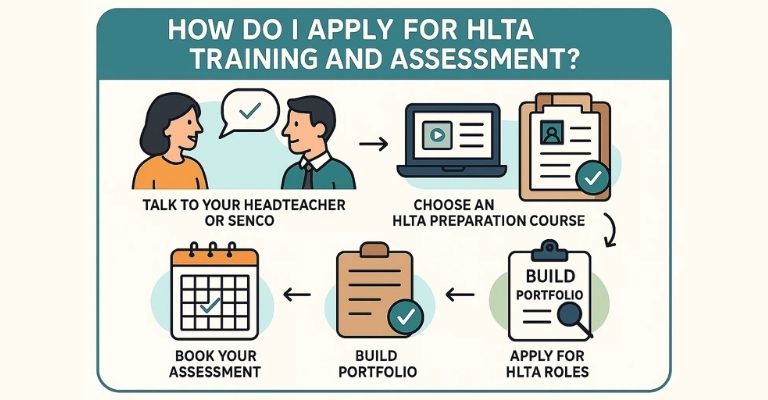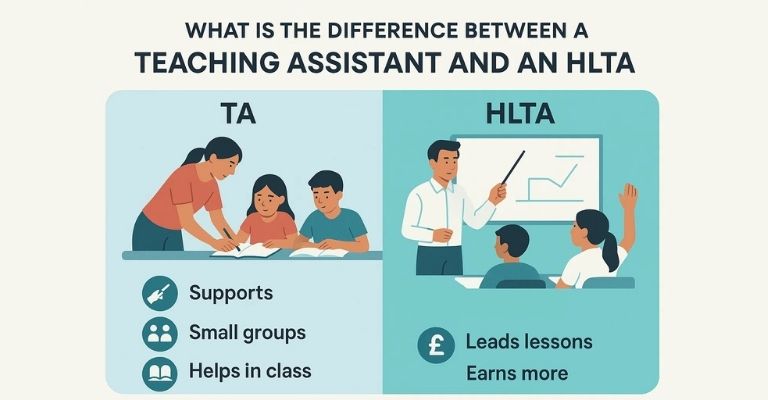Have you ever wondered, “How do I become a higher level teaching assistant?” You’re not alone — and the good news is, it’s more achievable than you might think! Since 2004, over 60,000 people have achieved HLTA status in the UK (according to training providers), showing just how many TAs have successfully taken this step. To join them, start by gaining solid experience as a TA and ensure you have GCSEs in English and maths (9–4/C) or an equivalent. Then, gather strong references, complete HLTA preparation, and pass the HLTA Status assessment. Finally, apply for HLTA roles in schools or MATs to take that rewarding step forward.
In this guide, we’ll cover what HLTAs do, the skills and training you need, how to gain experience, and how to get your first HLTA role. Additionally, we’ll look at the career paths this role can open.
What Is a Higher Level Teaching Assistant (HLTA)?
A Teaching Assistant (TA) supports teachers in the classroom, helping students with their work and ensuring lessons run smoothly. They assist with day-to-day activities, support individual or small groups of students, and help create a positive learning environment.
Building on this role, a Higher Level Teaching Assistant, or HLTA, takes on additional responsibilities. They can lead lessons when a teacher isn’t around, support small groups of students, and provide extra help to those who need it. HLTAs also monitor student progress and help keep the classroom running efficiently. In short, they take on more responsibility and make a real difference for every child in the class.
Want to learn more about the HLTA role and how to become one? Check out our full guide on our blog: What Is a Higher Level Teaching Assistant (HLTA)?
What Does an HLTA Do in Schools?

An HLTA supports learning and helps the classroom run smoothly. Their daily tasks include:
- Planning and leading small group activities
- Covering whole lessons when the teacher is away
- Demonstrating tasks and guiding students
- Checking how well students are learning
- Adapting activities for children with SEND
- Organising and coordinating classroom resources
- Supporting behaviour and daily routines
- Giving feedback to teachers on progress
How Do I Become a Higher Level Teaching Assistant?
To become an HLTA, you usually need:
- GCSEs in English and maths (9–4/C) or an equivalent qualification
- Many employers also prefer a Level 3 Teaching Assistant or Supporting Teaching & Learning certificate
- Proof that you meet HLTA standards
You can also boost your chances with short courses like:
- Safeguarding and child protection
- First aid
- Behaviour management
- Phonics or SEND training
These extra courses show schools you’re ready to take on more responsibility and support students flowlessly.
Do I Need Experience Before Training as an HLTA?
Yes! Most schools want you to have solid TA experience before starting HLTA training. They look for proof that you’ve made a difference in the classroom. Examples include:
- Leading small groups of students
- Helping children who need extra support
- Covering lessons when the teacher isn’t there
These experiences show that you’re ready to take on more responsibility and step up as an HLTA.
What Skills Help Me Succeed as a Higher Level Teaching Assistant?
To succeed as an HLTA, you need a mix of practical skills and confidence. Key skills include:
- Classroom management – keeping lessons organised and students focused
- Differentiation – adjusting tasks so every student can learn
- Assessment for learning – checking how well students are doing and what they need next
- Communication – talking clearly with students, teachers and parents
- Teamwork – working well with teachers and other staff
- SEND awareness – supporting children with special educational needs
- Confident whole-class delivery – leading lessons when needed
These skills help you support learning effectively and make a real impact in the classroom.
How Do I Apply for HLTA Training and Assessment?

Applying for HLTA training and assessment is straightforward if you follow the steps:
- Talk to your headteacher or SENCo – let them know you want to take the next step.
- Choose an HLTA preparation course – find a provider that matches your needs.
- Build your portfolio – show examples of your work that meet HLTA standards.
- Book your assessment – once your portfolio is ready and endorsed by your school.
- Apply for HLTA roles – check local authority or MAT job boards for suitable posts.
Following these steps helps you move smoothly from TA to HLTA and show schools you’re ready for extra responsibility.
How Long Does It Take to Qualify as an HLTA?
Becoming an HLTA doesn’t have to feel overwhelming. Firstly, you can usually complete the preparation course alongside your current TA work in just a few months. Meanwhile, you’ll collect evidence for your portfolio and get your school’s approval. Then, once your portfolio is ready, you can book the HLTA assessment. Finally, moving into an HLTA role depends on your school and whether there are vacancies. With the right effort and planning, many TAs become HLTAs within a year or less—and it’s such a rewarding step forward!
At Unified Course, we make your HLTA journey easier and flexible. Our CPD-accredited course is affordable, offers unlimited access and lets you learn at your own pace—finish anytime, anywhere. Take charge of your professional growth and step forward today.
What Checks and Documents Do I Need?
Before you can train or apply as an HLTA, schools need to see some important documents. Make sure you have:
- An enhanced DBS check with the children’s barred list
- Right-to-work documents and a photo ID
- Proof of address
- Two references from previous employers or schools
- Safeguarding training record
It’s important that all these documents are up to date so your assessment and interviews go smoothly.
How Much Do Higher Level Teaching Assistants Earn in the UK?
If you’re wondering how much an HLTA can earn, here’s the scoop. Firstly, most HLTAs are paid on local authority NJC pay scales which are higher than regular TA grades. However, keep in mind that many roles are term-time only, so the salary is usually pro-rata. In addition, some positions offer extra pay for SEN or other responsibilities, depending on the council. Therefore, to get an accurate picture, always check your local authority’s NJC pay table and the banding listed in job adverts. Knowing this is worth it, as it helps you plan your next career step with confidence!
Want to find out more about Teaching Assistant salaries? Read our full blog article: “Teaching Assistant Salary in the UK 2025”
What Is the Difference Between a Teaching Assistant and an HLTA?

Teaching Assistant (TA)
A teaching assistant mainly supports the teacher and helps students in class. They assist with lessons, work with small groups, and make sure the classroom runs smoothly. Basically, they’re there to help everyone get the most out of learning.
Higher Level Teaching Assistant (HLTA)
An HLTA takes on more responsibility. They meet national HLTA standards, can lead lessons, cover classes when the teacher isn’t there, run small group interventions, and support assessments. On top of that, they usually earn more. In short, HLTAs play a bigger role in helping students learn and keeping the classroom on track.
Can an HLTA Teach a Class Full Time?
You might wonder if an HLTA can run a class all day. The short answer is: not usually. HLTAs can lead lessons and cover a class when the teacher is away, but they aren’t fully qualified teachers, so they don’t take full-time responsibility.
Nevertheless, HLTAs still play a big role in the classroom. They support learning, run small group sessions, help students who need extra support, and keep the class running smoothly. Occasionally, schools may let an HLTA teach for longer periods if a teacher is absent; however, this is always under supervision and within the HLTA standards.
In summary, HLTAs are a vital part of the classroom team, helping students learn and keeping everything on track, even when the teacher can’t be there.
Can Becoming an HLTA Lead to a Teaching Career?
Yes, definitely! Firstly, becoming an HLTA is a great way to step closer to becoming a teacher. Many teachers started as TAs, then became HLTAs, and later trained to teach. Moreover, being an HLTA makes your application stronger if you want to do QTS, a PGCE, or a school-based apprenticeship. Additionally, if you’re missing GCSEs, don’t worry—you can take equivalency tests or Functional Skills to catch up. In short, being an HLTA gives you real classroom experience and shows schools that you’re ready for the next big step!
FAQs
How to be a higher level teaching assistant?
Gain solid TA experience, complete HLTA preparation, pass the HLTA assessment, and apply for HLTA roles.
What is the highest level for a teaching assistant?
The HLTA (Higher Level Teaching Assistant) is the highest standard before moving into teaching or leadership roles.
How long does it take to become a higher level teaching assistant?
With preparation and portfolio work, many TAs become HLTAs within a year or less.
How to get paid more as a teaching assistant?
Gain HLTA status, take Level 3 qualifications, specialise in SEN, or take on extra responsibilities.
Is there a level 4 teaching assistant?
Not officially, HLTA is generally at the top recognised level in schools, though some schools may have senior TA roles beyond HLTA.
Final Steps: How to Start Your HLTA Journey
Now you’re almost ready to answer the question: how do I become a higher level teaching assistant. First, gather your GCSEs or Functional Skills certificates. Next, have a chat with your headteacher or SENCo about your plans—they can guide you and support you on your journey. Then, choose an HLTA preparation course and start building your portfolio to show you meet the HLTA standards. Additionally, update your CV with examples of lessons you’ve covered and groups you’ve supported. Finally, apply for HLTA-banded roles in schools or MATs.
Step by step, you’ll move closer to becoming a confident HLTA and making a real difference for your students.
Excited to get started? Take a look at the Higher Level Teaching Assistant Course at Unified Course and start gaining the skills and portfolio you need to succeed!





